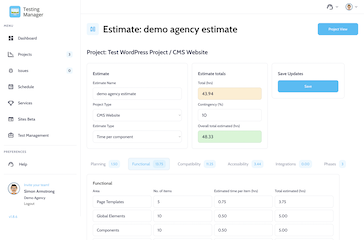You and your team launch a website and then sit back and relax after all the energy you used on building the site, fixing bugs, carrying out testing, arranging and proof reading content and checking every last detail before going live.
Unfortunately, as soon as the website launches (if not before) it is necessary to plan the next set of testing.
After weeks of getting the site finished and ready to launch, which normally includes quite a lot of testing, the last thing many people want to think about is more testing.
But this continual testing is needed, and here are some suggestions as to why.
Why you need to keep testing
- Any bug fixes put off until after launch will need to be retested.
- Depending on severity of the fixes, you may need to retest whole sections or even the whole site again to make sure that these fixes don't break anything else.
- You need to keep tabs on your SEO, make sure that new pages are getting indexed, that rankings and traffic are not dropping and that there are no issues reported by Google Webmaster Tools (or Bing).
- You need to make sure that the new website is receiving enquiries and signups, i.e. do all your forms still work?
- If it is an ecommerce site then are you receiving new purchases correctly? Does your payment processing continue to work properly?
- Are your goal conversions functioning correctly?
- You need to continue to monitor your website's uptime and performance.
- For critical applications and ecommerce sites you may go further and monitor specific journey steps to make sure performance continues to be acceptable.
- Do you have any particularly busy time of the year? You'll need to monitor the performance prior to and then throughout that period.
- You might even want to carry out some load testing ahead of that busy period to make sure your website can cope with the increased traffic.
- Any specific marketing campaigns or landing pages need checking to make sure that they are still functioning correctly and converting as well as before.
- Do you have any Conversion Rate Optimisation (CRO) plans? That is pretty much the essence of ongoing testing to continually develop the site in order to increase conversions.
- Websites are often developed in phases, the next phase of your site will need fully testing before it is launched and then the site will need retesting once the new phase is live.
- Any new content such as blog posts, new pages, case studies, testimonials, etc. need proof reading, grammar checking and the links checking before they are added to the site.
- New browsers and browser versions are regularly released, you need to check to make sure your website continues to work properly in these new browsers.
- And that goes for new mobile devices and new versions of iOS or Android too (or Windows and Blackberry should your website traffic warrant it).
- If you have a Members or Clients area, can your Members or Clients continue to login and carry out the tasks available to them?
- With the new content, bug fixes and new developments being added, is your site still hitting HTML and CSS validation standards?
- Is your website still achieving the accessibility standard you set out at the start of the project?
You need a plan
So you can see that having a plan for what ongoing testing you need to do and how you are going to go about it is necessary. This plan will help to make sure your website is in as good a shape in 6 months after the original launch.
Are there any other reasons why you might need to continue to test your website regularly? Please let me know in the comments.
Image used courtesy of Salim Virji



